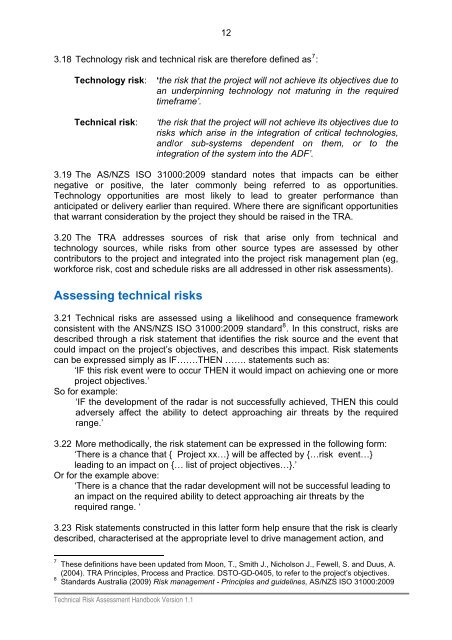Technical Risk Assessment Handbook - Defence Science and ...
Technical Risk Assessment Handbook - Defence Science and ...
Technical Risk Assessment Handbook - Defence Science and ...
You also want an ePaper? Increase the reach of your titles
YUMPU automatically turns print PDFs into web optimized ePapers that Google loves.
12<br />
3.18 Technology risk <strong>and</strong> technical risk are therefore defined as 7 :<br />
Technology risk:<br />
<strong>Technical</strong> risk:<br />
‘the risk that the project will not achieve its objectives due to<br />
an underpinning technology not maturing in the required<br />
timeframe’.<br />
‘the risk that the project will not achieve its objectives due to<br />
risks which arise in the integration of critical technologies,<br />
<strong>and</strong>/or sub-systems dependent on them, or to the<br />
integration of the system into the ADF’.<br />
3.19 The AS/NZS ISO 31000:2009 st<strong>and</strong>ard notes that impacts can be either<br />
negative or positive, the later commonly being referred to as opportunities.<br />
Technology opportunities are most likely to lead to greater performance than<br />
anticipated or delivery earlier than required. Where there are significant opportunities<br />
that warrant consideration by the project they should be raised in the TRA.<br />
3.20 The TRA addresses sources of risk that arise only from technical <strong>and</strong><br />
technology sources, while risks from other source types are assessed by other<br />
contributors to the project <strong>and</strong> integrated into the project risk management plan (eg,<br />
workforce risk, cost <strong>and</strong> schedule risks are all addressed in other risk assessments).<br />
Assessing technical risks<br />
3.21 <strong>Technical</strong> risks are assessed using a likelihood <strong>and</strong> consequence framework<br />
consistent with the ANS/NZS ISO 31000:2009 st<strong>and</strong>ard 8 . In this construct, risks are<br />
described through a risk statement that identifies the risk source <strong>and</strong> the event that<br />
could impact on the project’s objectives, <strong>and</strong> describes this impact. <strong>Risk</strong> statements<br />
can be expressed simply as IF…….THEN ……. statements such as:<br />
‘IF this risk event were to occur THEN it would impact on achieving one or more<br />
project objectives.’<br />
So for example:<br />
‘IF the development of the radar is not successfully achieved, THEN this could<br />
adversely affect the ability to detect approaching air threats by the required<br />
range.’<br />
3.22 More methodically, the risk statement can be expressed in the following form:<br />
‘There is a chance that { Project xx…} will be affected by {…risk event…}<br />
leading to an impact on {… list of project objectives…}.’<br />
Or for the example above:<br />
‘There is a chance that the radar development will not be successful leading to<br />
an impact on the required ability to detect approaching air threats by the<br />
required range. ‘<br />
3.23 <strong>Risk</strong> statements constructed in this latter form help ensure that the risk is clearly<br />
described, characterised at the appropriate level to drive management action, <strong>and</strong><br />
7 These definitions have been updated from Moon, T., Smith J., Nicholson J., Fewell, S. <strong>and</strong> Duus, A.<br />
(2004). TRA Principles, Process <strong>and</strong> Practice. DSTO-GD-0405, to refer to the project’s objectives.<br />
8 St<strong>and</strong>ards Australia (2009) <strong>Risk</strong> management - Principles <strong>and</strong> guidelines, AS/NZS ISO 31000:2009<br />
<strong>Technical</strong> <strong>Risk</strong> <strong>Assessment</strong> <strong>H<strong>and</strong>book</strong> Version 1.1

















